
views
Calming Down In the Moment

Stop what you’re doing. One of the best ways to calm down if you’re already feeling stressed is to stop interacting with the stressor, if possible. Sometimes, even taking a few seconds before you head back into the situation can be enough to help you cool down. Try counting to ten, or taking 3-5 deep breaths before you reply in a heated conversation or situation. Take a break. For example, if an argument with your spouse is getting heated, stop and excuse yourself for a moment by saying something like, “I’m feeling a little overwhelmed right now. I need to take a 15-minute break before we continue discussing this.” Go to a different place, focus on breathing deeply, and recite a calming mantra, such as “I can handle this calmly. I can do this.”

Focus on your senses. When we’re stressed, sometimes our bodies interpret the stress as an attack and kick us into “fight or flight mode.” This stimulates the release of hormones like adrenaline, which constrict your blood vessels, make your breathing rapid and shallow, and boost your heart rate. Over time, this panic response can become a habit for your brain in what’s known as “automatic reactivity.” Slowing down and focusing on the individual physical responses you’re experiencing can help you learn to identify what it feels like when you’re stressed to the max. Studies also show that this conscious process of noticing what’s going on in your body can help retrain your brain’s automatic habits. Notice each thing that is going on in your body but try to avoid judging it. For example, if you’re worried about doing well on a final exam that’s in just a few minutes, you might notice to yourself, “My face feels hot and flushed. My heart is beating very fast. My palms feel sweaty. I feel nauseated.” Try to keep your noticing these things as neutral as possible.
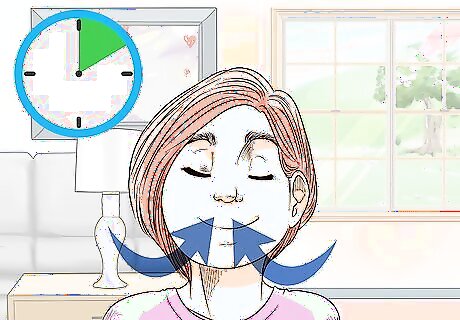
Take some deep breaths. When your body enters “fight or flight mode,” your sympathetic nervous system can seriously mess with your breathing. You may find it difficult to breathe when you’re stressed, but it’s important to focus on taking some long, even breaths. This will restore oxygen to your body and decrease lactate in your bloodstream, making you feel calm and relaxed. You’ll probably notice that when you’re stressed or upset, your breathing seems to come from the very top of your chest, even your throat. Aim to breathe from your diaphragm instead. Place one hand on your lower abdomen just below your ribs and one on your chest. Inhale slowly through your nose. Aim to breathe in for a 4-count if you can. You should feel your belly expand along with your chest as you inhale: this is diaphragmatic breathing. Hold your breath for 1-2 seconds. Then, slowly exhale through your nose or mouth. Aim to exhale for a 4-count if you can. Repeat this process 6-10 times per minute for a few minutes. You may also find it helpful to recite a mantra while you breathe, or count your breaths to keep yourself from getting distracted. A mantra may be a syllable, such as "ohm," or it may be a phrase, such as "breathing into my body [while inhaling], breathing out release [while exhaling]."

Try to relax your muscles. When you’re stressed, you may unconsciously tighten and tense your muscles, which can make you feel even more stressed and “wound up.” Using progressive muscle relaxation, or PMR, can help release that tension and get you feeling more calm and relaxed. PMR focuses on consciously tensing and then releasing muscles in groups. There are several free guided PMR routines online. Berkeley has a script you can follow along with. MIT has a free 11-minute audio guide to doing PMR. Find a quiet, comfortable place if you can. If this is not possible, you can still do some PMR techniques. Loosen tight clothing if possible. Sit comfortably or lie down (although lying down may relax you so much that you fall asleep!). Breathe evenly as you do your PMR groups. Begin with the muscles in your face, as many people carry stress in their face, neck, and shoulder area. Start by opening your eyes as wide as they will go for 5 seconds, then release the tension. Squeeze your eyes shut tightly for 5 seconds, then release the tension. Give yourself 10 seconds to notice how these areas feel. Move to the next group. Purse your lips tightly for 5 seconds, then release. Smile as wide as you can for 5 seconds, then release. Again, let yourself enjoy the sensation of relaxation for 10 seconds before moving on. Continue to tense muscle groups for 5 seconds and then release the tension. Give yourself a 10-second relaxation break between groups. Progress through the rest of your muscle groups (if time allows): neck, shoulders, arms, chest, stomach, buttocks, thighs, lower legs, feet, and toes. If you don't have time for a full PMR release, try to do it with just your facial muscles. You can also try a quick hand massage, since we often carry a lot of tension in our hands.

Get some exercise. Exercise is a natural mood booster because it releases endorphins, natural chemicals that make you feel calm and happy. Several studies have demonstrated that exercising regularly can make you feel calmer and happier overall. Whether you go for a run, do calisthenics, do yoga, or lift weights, 30 minutes of physical exercise every day can help you relax. Exercise may also have a preventive effect. Studies have shown that getting some aerobic exercise before an experience that may be stressful can actually help you keep calm during that experience. Try exercises such as yoga and tai chi. Their focus on deep breathing, meditation, and gentle physical movement can really help soothe you.
Identifying the Source(s) of Stress

Recognize what stress looks like for you. You may exhibit a variety of signs when you’re feeling stressed or anxious. Knowing what to look for will help keep stress from sneaking up on you unawares. Everyone experiences and responds to stress differently, but there are some common symptoms you can look for: Psychological signs can include: trouble concentrating, difficulty with your memory, being distracted easily, feeling less creative or decisive, worrying, or frequent negative thinking. Emotional signs can include teariness, irritability, mood swings, unusual feelings for you, defensiveness, feeling a lack of motivation or the desire to procrastinate, low confidence or low self-esteem, frustration, feeling nervous or jittery, uncharacteristic aggression or anger. Physical signs can include: aches and pains, a lowered immune system, weight or sleep changes, panic attacks, exhaustion or fatigue, and change of sex drive. Behavioral signs can include: forgetfulness, self-neglect, social withdrawal, trouble sleeping, relationship trouble, impaired time-management and self-motivation, and using substances such as alcohol, nicotine, or drugs to help cope.
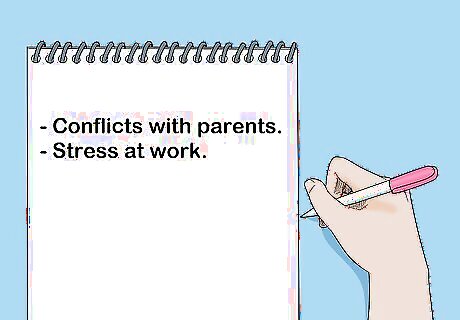
Identify the cause of your stress. Is your heart pounding because that person just cut you off on the freeway, or is it because of that presentation you have to give to your boss this afternoon? Think for a moment and try to figure out what’s really bothering you. If it helps, you can write various things down on a piece of paper and then rank them. Common sources of stress include: Family. Conflicts with parents, loved ones, or your romantic partner can really stress you out. School or work. You may feel pressure to perform, meet deadlines, or achieve certain tasks. You may also feel stressed about balancing work and your personal life, or about making major decisions. Personal. These sources can be intense. You may worry about feeling “good enough.” You may be stressed over your relationships, or you may have problems with your health or finances that stress you out. You may also be bored or lonely, or have limited relaxation and self-care time.

Acknowledge your role. It may be that stress has become so integral to how you envision yourself that you don’t even recognize how tied up you have become. Take a step back and consider how you think about stress. Do you frequently feel stressed out even if the stress always seems temporary? For example, you might say something like “It’s just really crazy at work this week” to explain your stress. However, if you are often feeling this stress, this suggests it is more than a temporary “bump” that’s causing it. Do you feel like stress is part of your identity or a “normal” part of your life? For example, perhaps you think, “My family is full of worriers. That’s just how we are” or “I just live a stressful life, that’s all.” This type of thinking can make it seem like there’s nothing you can do to manage your stress. Do you feel like your stress is others’ fault or responsibility? For example, you might blame the stress about a college essay on the teacher’s strict standards, rather than your procrastination. This can keep you from taking action to reduce your stress by changing your own behavior.

Determine if you’re stressing about something that is in the past. Sometimes, we can get caught up in obsessing over the past to the point that it stresses us out in the present. You can’t change the past, but you can respond to the present and prepare for the future. Constantly rehashing something that happened in the past can be a sign of rumination, an unhealthy thinking habit where you repeat a “broken record loop” of negative ideas. This can cause anxiety and depression. It is also unproductive because ruminating doesn’t teach you anything about the past experience or help you problem-solve for the future. Instead, if you catch yourself stressing about something that has already happened, take a moment to remind yourself that you cannot change the past. However, you can learn and grow from it, and you can use its lessons to do better in the future. For example, if you find yourself thinking, “Why do my partners always break up with me? I’m just a loser,” this is unhelpful and it could definitely cause you stress. Try thinking about your past in a more productive way. For example, you could examine your past relationships for trends, such as the type of person you generally date, your communication styles, or events that surrounded each breakup. You may find patterns that help you understand what’s going on and make new plans for future relationships. You also avoid essentializing yourself, which will help you feel motivated to make any changes you need.

Determine whether you’re stressed about the future. We all worry about our futures at some point. However, we can get so wrapped up in anticipating the future that we stress out and forget to live in the present. This type of thinking isn’t helpful, but you can learn to change it. Remember: the future isn’t set. A common type of worry about the future is “catastrophizing,” where you predict the worst possible scenario for any event, even minor ones. For example, if you’re feeling stressed about an upcoming exam, catastrophizing could look like this: “If I don’t make a good grade on that test, I’m going to fail the course. I could even fail the semester. If I fail the semester I will lose my scholarship and I won’t be able to go to college anymore. I’ll end up with no money and no job and I’ll have to live under a bridge in a box.” Obviously, this is an extreme example, but it illustrates the kind of thinking that can happen. One way to challenge this is to imagine the absolute worst thing that could actually happen. For example, in the above scenario, the worst thing might be that you do indeed fail out of that college and have to move back in with mom and dad. Then, consider whether you could handle it. Chances are almost always yes. Finally, consider the real likelihood that this will occur. In this case, it’s pretty slim: a failed test does not equal failing a class, which does not equal failing out of college, etc. You can also challenge catastrophizing by stopping yourself at each “conclusion” and finding logical evidence and counterpoints for it. For example, if you fail the exam, you might fail the course -- or you might be able to retake the exam, or bring up your grade for extra credit.
Making a Plan

Practice relaxation. You should always try to make plans and decisions when you’re calm and relaxed. If you’re feeling stressed or angry, that could impair your judgment and lead you to make rash or unhelpful decisions. Inhale deeply through your nose. In your mind, count to five seconds, and then exhale slowly through your mouth, for another five seconds. Repeat this breathing pattern until you feel comfortable with it. Think about something else. Get your mind off the stress by thinking about something that makes you happy, such as your kids or spouse (provided they’re not the cause of the current stress), or by concentrating on the things you have planned for the day. Visualize relaxing things, such as a deserted island or a country road. Close your eyes and try to picture even minor details about the imaginary place, and you can put yourself in that situation instead of the one you’re in. Get away from the cause of the stress. If you can physically escape the stress trigger, do so. Leave the room or pull off the road for a moment to put things in perspective. Acknowledge that anxiety is not always bad. Sometimes, anxiety or stress can be a clue that you’re considering a significant or even unhelpful decision. For example, you might feel stressed about selling all of your belongings, buying a school bus, and living a nomadic life in the desert. This is obviously a big decision, and whether or not it’s a good fit for you is something you need to consider seriously. Anxiety is your warning sign here to slow down and think carefully.

Choose your response. In general, you have two responses when you face stress: you can choose to change either the situation or your response to it. Even if you’re powerless to change the source of your stress, you have the power to choose how you’ll respond to it. You can choose to learn new techniques to respond in the moment. You can choose to refocus your thinking. Consider some questions when deciding your approach. Can you avoid it? You can sometimes avoid stressors, thereby changing the situation. For example, if you frequently find yourself stressed by your busy schedule, you can examine your agenda for things you could drop. You could also learn to say “no” to requests more frequently, or ask for help. Can you alter it? Some stressors can’t be avoided, but you can alter your approach to them and thus change the situation. For example, you and your romantic partner will have disagreements at some point; this is natural for all relationships, even if you’re the most loving couple in the world. However, these don’t have to be stressful if you alter your approach, such as seeking compromise or expressing your feelings directly instead of using passive aggression. Can you adapt to it? Sometimes you can change your approach or behaviors to reduce stress, even if you can’t change the situation. For example, if you frequently find yourself stressed by rush-hour traffic, you can’t change that: you have to get to work, and rush-hour traffic is a worldwide problem. However, you could alter your approach to this stressor by taking public transit to work, finding a different route home, or leaving a little earlier or later in the day. Can you accept it? Some things you simply cannot change. You cannot change or control others’ feelings, actions, or reactions. You can’t change the fact that it rained on your wedding day, or that your boss is a selfish jerk no matter how hard you try to be a good communicator. However, you can accept these as things beyond your control and let go of your need to control them. You can also view them as learning experiences from which you can grow.
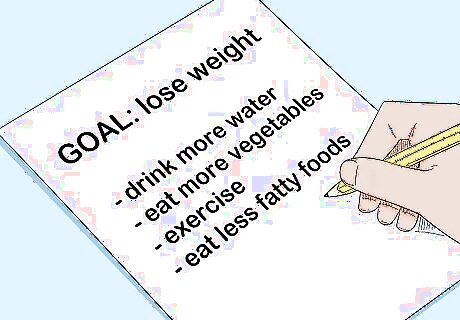
Make a plan. Sometimes you can resolve a stressful situation right away with one action, but often you’ll need several steps, perhaps over a long period. Write out a plan with attainable goals and a timeline for reaching those goals. Additionally, many stressful situations are avoidable. If you prepare ahead of time for important events and make contingency plans, you may not have to cope with as much stress later. An ounce of prevention is worth a pound of cure.

Be realistic. If you continue to experience stress because no matter how hard you try you can’t take the steps quickly enough, you probably haven’t set realistic goals. In a culture that values a can-do attitude, it can be hard to accept that sometimes you can’t do something, at least not within a given period of time. If that’s the case, revise your timeline or lower your expectations. If you can’t do that, the situation qualifies as one which you can’t control. Learn from your experience, but let it go. If you find yourself constantly failing to meet someone else's unrealistic standards, read How to Stop Being a People Pleaser and How to Overcome Martyr Syndrome.

Take one step at a time. A complex problem can be overwhelming, even when you’ve got your plan mapped out, but remember: the journey of a thousand miles begins with a single step. Just focus on one small goal at a time. Show yourself patience and kindness as you enact your plans. Remember that personal growth is hard work that does not come quickly. If you encounter setbacks or challenges (and most likely, you will at some point), view them as roadblocks from which you can learn new ways of approaching the situation, rather than “failures.”
Taking Action

Stop procrastinating. Procrastination often results from fear and anxiety, which can stop us dead in our tracks. Often, perfectionism is a culprit. You may get so wrapped up in needing to be “perfect” (which is both highly subjective and always unattainable) that you find yourself unable to actually do what you need to do because you’re worried it won’t turn out as you hope. Fortunately, you can learn some techniques to help you overcome procrastination and the stress it can cause. Remind yourself that you cannot control outcomes, only actions. You might be so stressed about what your professor will think about your essay that you can’t face writing it. Remember that you can control what you do: you can do your best and write your best essay. The rest of it is out of your hands. Acknowledge that “perfection” is an unrealistic standard. No human can attain perfection and our ideas of what “perfect” means are highly variable anyway. Instead, aim for your personal best and avoid making assumptions about yourself based on outcomes. For example, a perfectionist might see a B+ on an essay as a “failure” because it is not a perfect grade. However, someone who is aiming for her personal best could reframe this: she knows she did the best she could and she can be proud of that effort, regardless of what the grade on the essay says. Watch out for “should” statements. These insidious thoughts can encourage you to beat yourself up over things that are out of your control. For example, you might have the thought, “A good student should never make mistakes.” However, that is an unrealistic standard that no one can meet. Instead, try a “can” statement: “I can perform to my best ability and honor my effort, even when I make mistakes. Everyone makes mistakes in life.”

Practice mindfulness. You can’t eliminate all stress from your life, and in fact, you wouldn’t want to. Stress can be a great motivator. It can even be a sign that you’re deeply invested in what you’re doing or about to do. Mindfulness techniques can help you notice when you experience stressful sensations and acknowledge those feelings without judging them. This will help you avoid focusing too much on the stress. Here are a couple of exercises to try: Try the raisin meditation. It may sound a little silly, but this exercise can help you learn to slow down and focus on the present moment. As you interact with your handful of raisins, you will pay careful attention to each element of your experience, acknowledging it to yourself. Try it for 5 minutes a day. Begin with a handful of raisins. Take one between your fingers and hold it. Turn it around, notice its texture, its ridges and valleys. Make a mental note of what the raisin feels like. Examine the raisin visually. Take time to really see the raisin, as though you were an explorer from another world whose first contact with Earth is this remarkable wrinkled thing. Notice its colors, shape, and texture. Smell the raisin. Hold the raisin to your nose and take a few deep breaths. Enjoy any aroma that you smell. Try to describe it to yourself. You may even find that certain raisins smell different than others! Place the raisin on your tongue. Notice how it feels there. Can you feel the weight? Can you move it around your mouth, exploring how it feels in different places? Taste the raisin by taking a small bite. Notice now how you move your mouth as you chew it. Try to discern what muscles you’re using to chew. Notice how the texture and taste of the raisin respond to your chewing. Swallow the raisin. Try to see if you can follow the raisin as you swallow. What muscles are you using? What does it feel like? Try a self-compassion break. We can get so wrapped up in the daily stresses of our lives that we become accustomed to judging ourselves for them. A quick self-compassion break for just 5 minutes can help you become more mindful of when you are being harsh with yourself. Think of the stressful situation. Notice any sensations of stress in your body, or any emotions you are feeling. Repeat to yourself, “This is a moment of suffering” or “This is stress.” Acknowledging that this is what is happening without judging it will help you become more mindful of your experience. Now repeat, “Stress is a natural part of life” or “Everyone has negative experiences sometimes.” This will help you recognize your common humanity with others. You are not deficient or “bad” for experiencing these things. Place your hands over your heart or wrap your arms around yourself to give yourself a hug. Repeat to yourself, “May I be kind to myself” or “May I be patient.” You can say whatever seems most relevant to your situation, but keep it phrased positively. The Greater Good in Action center at Berkeley has a bunch of other evidence-based exercises that you can practice at their website.
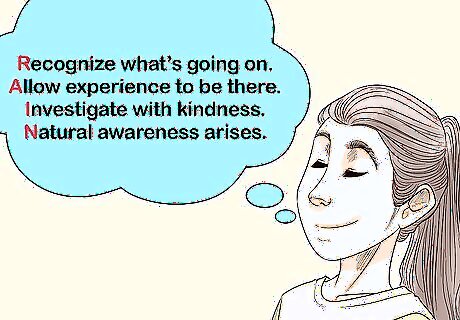
Use the RAIN reminder. RAIN is a helpful acronym invented by psychologist Michele McDonald to help you practice a mindfulness approach. It stands for: Recognize what is going on. Consciously notice and recognize whatever is going on right now, in this moment. This means acknowledging feelings or thoughts that seem negative as well as those that seem positive. For example, “I am feeling very angry and stressed right now.” Allow the experience to be there as it is. This means that you acknowledge whatever is going on in your mind and heart without judgment. It’s tempting to judge yourself for seemingly “negative” feelings or reactions or to try and avoid or repress those things. Instead, notice them and acknowledge even the unpleasant thoughts and feelings as valid parts of your experience. For example, “I feel so angry with my partner but also ashamed that I snapped at her.” Investigate with kindness. This crucial part involves showing yourself and others compassion as you investigate your present moment. Ask yourself what your thoughts and feelings reflect about your beliefs and needs right now. For example, if you are feeling angry with your partner and ashamed that you snapped at her, you might direct harsh judgment toward the both of you: “I’m a bad person for yelling at her. She makes me so mad.” Instead, try to approach both people with kindness: “I yelled at her, and I’m feeling ashamed by that because I love her. I made a mistake that I can acknowledge. My partner said things that made me angry, but I know she also loves me. We can work together to solve this issue.” Natural awareness arises from not over-personalizing the experience. This means extricating yourself from that tendency to generalize about yourself based on one experience, such as “I’m a bad person” or “I’m a loser.” Your feelings are part of your experience, but they are not you. Allow yourself to acknowledge that you may have negative experiences or feelings without them defining who you are.
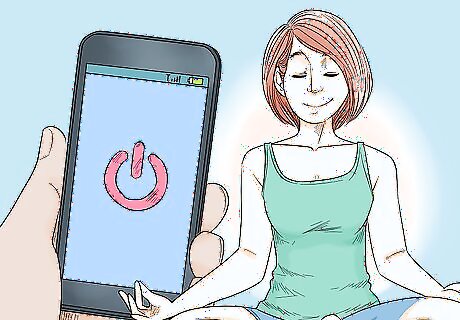
Meditate. Meditation is all about being quiet and accepting in the present moment. Meditation can help you feel calm and relaxed even through your day-to-day stresses. In fact, meditation can over time even rewire how your brain responds to stressors! Mindfulness meditation in particular has recently received a lot of scientific support for its benefits. You can do some meditation on your own, take a class, or use an audio guide. Begin by finding a quiet place without distractions or interruptions. Avoid having your TV, computer, or cellphone on. If you can, take at least 15 minutes to meditate (although 30 is even better). Close your eyes and breathe evenly and deeply. Begin by focusing just on your breath. You can gradually expand your focus to include your other sensory experiences. Notice your sensations without judgment. Acknowledge the thoughts you experience as thoughts, even if the thoughts seem negative to you: “I am having the thought right now that this is corny.” Accept the thought as it is, without trying to change or reject it. If you find yourself getting distracted, bring your thoughts back to noticing your breathing. You can also find free audio meditations online. MIT and the UCLA Mindful Awareness Research Center both have online MP3 meditations. You can also find mobile apps such as Calm that can help guide you.

Repeat positive statements. Challenge negative thoughts when they show up by repeating positive affirmations to yourself. You can train your brain to look for the best in you, not the worst, which can help reduce stress levels. Here are some examples: “I can do this.” “I can do my best. That is all I can do. That is enough.” “I am bigger than my problems.” “My mistakes do not define me.” “I am human. We all make errors.” “This is temporary and will pass.” “I can ask for help when I need it.”

Release stress productively. It can be tempting to handle stress in unproductive ways, such as turning to alcohol or other substances, or taking it out on another person, pet, or inanimate object. Avoid these tendencies and focus on productive ways to express your stress instead. Resist the temptation to blow up or lash out when you’re stressed, especially if you’re angry. Expressing your anger through shouting, physical violence, or even breaking or punching things can actually make your anger and stress worse. Try something less harmful, like squeezing a stress ball or doodling. On the other hand, swearing may actually help you feel better in a stressful or painful situation. Just be mindful of where you do it: obviously, dropping the f-bomb in front of your boss or cussing out your child could hurt not only you but others. Cry if you want to. Sometimes, you just need to cry. Doing so productively can actually help you feel better. Make sure to repeat calming, kind statements to yourself as you cry, and allow yourself to feel your feelings. Listen to some soothing music. The British Academy of Sound Therapy has put together a playlist of the world’s “most relaxing” music. Listening to some calm, soothing music when you’re stressed can provoke a physiological relaxation response. Take a hot shower or bath. Physical warmth has been shown to have a relaxing effect on many people.



















Comments
0 comment